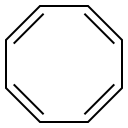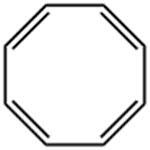Chemical Properties
1,3,5,7-Cyclooctatetraene (COT) is an unsaturated derivative of cyclooctane, with the formula C8H8. It is also known as [8]annulene. This polyunsaturated hydrocarbon is a colorless to light yellow flammable liquid at room temperature. Because of its stoichiometric relationship to benzene, COT has been the subject of much research and some controversy.
Physical properties
Cyclooctatetraene (COT) is a poster child for nonaromatic molecules. An isomer of tub-shaped COT, with one of the ring double bonds changed from the usual cis form to a trans one, lies some 23 kcal/mol higher in energy.
Cyclooctatetraene is an 8p electron system and has a triplet ground state if the p electrons are delocalized. It is antiaromatic hence highly unstable and reactive. It adopts a non-planar boat conformation to attain stability with alternating single and double bonds and hence behaves like a polyolefin.
Cyclooctatetraene is a nonaromatic 4n π-conjugated system with a non-planar tub-shaped geometry and potential energy surfaces at the ground state.
Uses
1,3,5,7-Cyclooctatetraene is used in the synthesis of highly organic film for silicon surfaces to improve its chemical and physical properties. It is also used in liquid state organic dye lasers, as triplet state quencher to reduce dye blinking.
Uses
Used in the synthesis of highly organic film for silicon surfaces to improve its chemical and physical properties. 1 Used in liquid state organic dye lasers. 2 Used as triplet state quencher to reduce dye blinking. 3
Uses
COT may be functionalized by two side groups which can be used as active anode materials for rechargeable batteries. High capacity and voltage organic cathodes may be developed by using COT that can be fused with carbon molecules.
Definition
ChEBI: An antiaromatic annulene that is cyclooctane having four double bonds at positions 1, 3, 5 and 7.
General Description
A colorless liquid. May irritate skin and eyes. Less dense than water and insoluble in water. Flash point 70°F. Vapors heavier than air. Used to make rubber.
Air & Water Reactions
Highly flammable. Insoluble in water.
Reactivity Profile
1,3,5,7-CYCLOOCTATETRAENE may react vigorously with strong oxidizing agents. May react exothermically with reducing agents to release hydrogen gas.
Health Hazard
Inhalation or contact with material may irritate or burn skin and eyes. Fire may produce irritating, corrosive and/or toxic gases. Vapors may cause dizziness or suffocation. Runoff from fire control or dilution water may cause pollution.
Purification Methods
Purify the triene by shaking 3mL with 20mL of 10% aqueous AgNO3 for 15minutes, then filtering off the AgNO3 complex which precipitates. The precipitate is dissolved in water and added to cold concentrated ammonia to regenerate the cyclooctatetraene which is fractionally distilled under vacuum onto molecular sieves and stored at 0o. It is passed through a dry alumina column before use [Broadley et al. J Chem Soc, Dalton Trans 373 1986]. [Beilstein 5 I 228, 5 IV 1331.]




